Bringing in a convenient for work type of micro-computer UKNTS Electronics MS 0511 architecture PDP-11
Good day comrades Habrovchane. Today I decided to make you happy with the first part of the story of bringing a Soviet microcomputer, UKNTS Electronics MS 0511, of the DEC PDP-11 architecture into a convenient for work type.
For me, this old car is interesting not only because it is built on the architecture of the PDP-11 and is not a direct clone of some kind of “western” car, but also nostalgic. It was the first real computer with which I dealt, before that there was only an experience with the programmable calculator Electronics MK-61. Which still works for me and I use it when I need to do the calculations, and sitting and coding in C ++ is too lazy. His reverse Polish notation well “enters into a stupor” of modern people, with their question “How should we count on it? Where is the button equal? ”But the article is not MK-61, although of course it’s also interesting, but about the UKSC.
I will not retell the story of creation and the performance characteristics of the UKSC, those who wish can read the article on the link in Wikipedia .
Other links with descriptions and photos are also easily accessible on Google, as well as the emulator which can be viewed here . In the same place documentation, archive of software and all the rest if who becomes interested.
')
In the meantime, I will briefly talk about UKSC. This is a computer-monoblock where the keyboard is built into the case. In the 80s, when the UKSC was developed as a standard solution for consumer PCs, it’s worth remembering the ZX-Spectrum, Amiga, Commodore, MSX and all the other “fed-up keyboards with a processor inside”.
And now I will not tire the venerable public with the sheets of the text and will start uploading the photo.

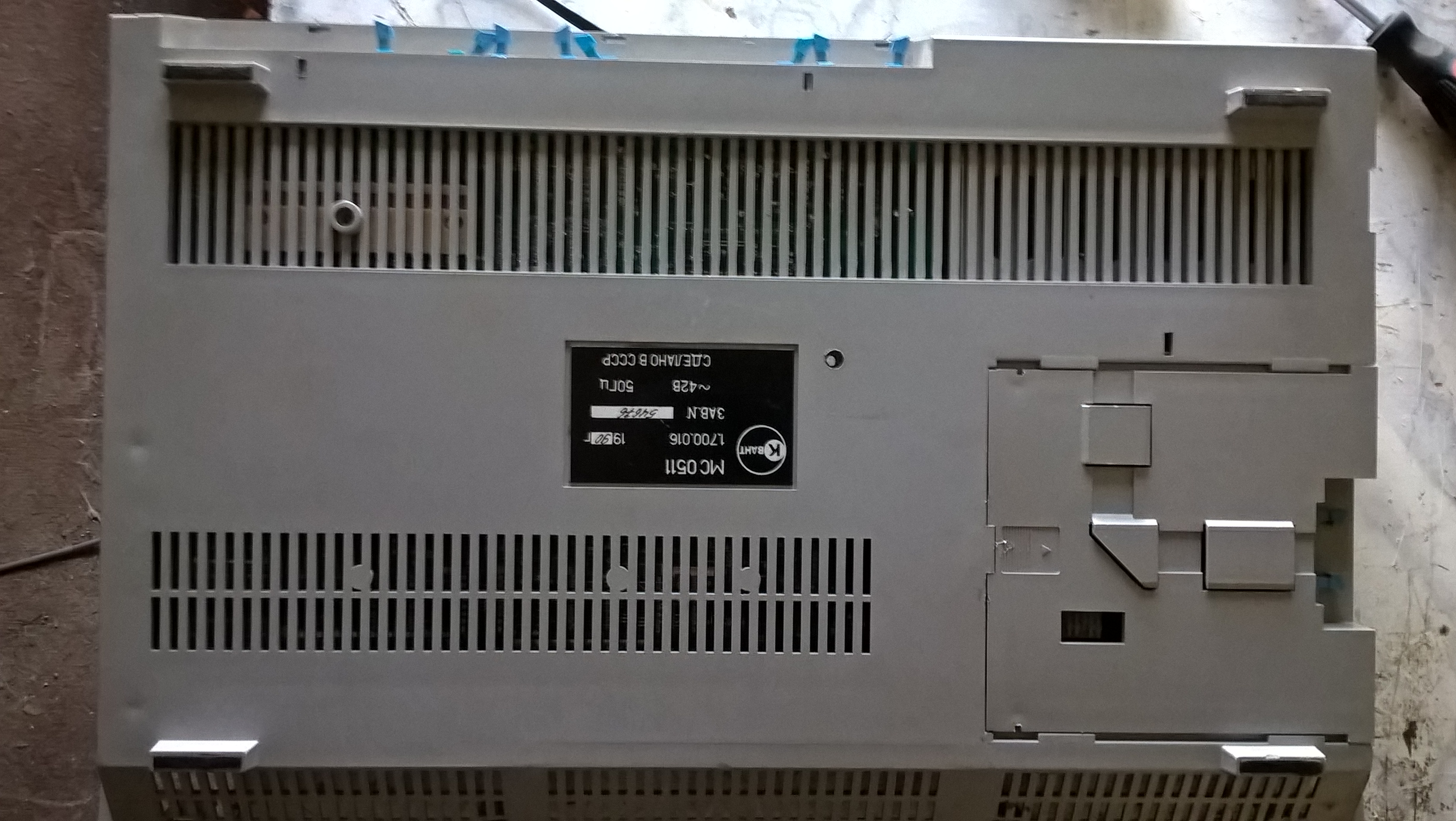
My copy of the UKSC, in fairly good condition for its age. This is a student model with a power supply at 42V 50 Hz, released in 1990 at the Kvant factory.
Despite the fact that the computer is almost 30 years old - it works.
A feature of the student model is a 42V power supply according to the rules of electrical safety and not soldered to save DC-DC converter +5 then ± 12V for power supply of interface chips of the Port C2 port which is a direct electrical analog of RS232 but with a Soviet connector and a different pinout.
I have a laboratory transformer 220-36 / 42B and he allowed to check the UKSC, but in modern conditions I consider its use not justified. It takes up a lot of space and buzzes quite loudly. For this reason, I decided to replace the UKNSC's power supply unit with a modern industrial power supply unit of a small size.
With the outer lid open, it is fastened with latches along the perimeter of the housing of the UKSC.

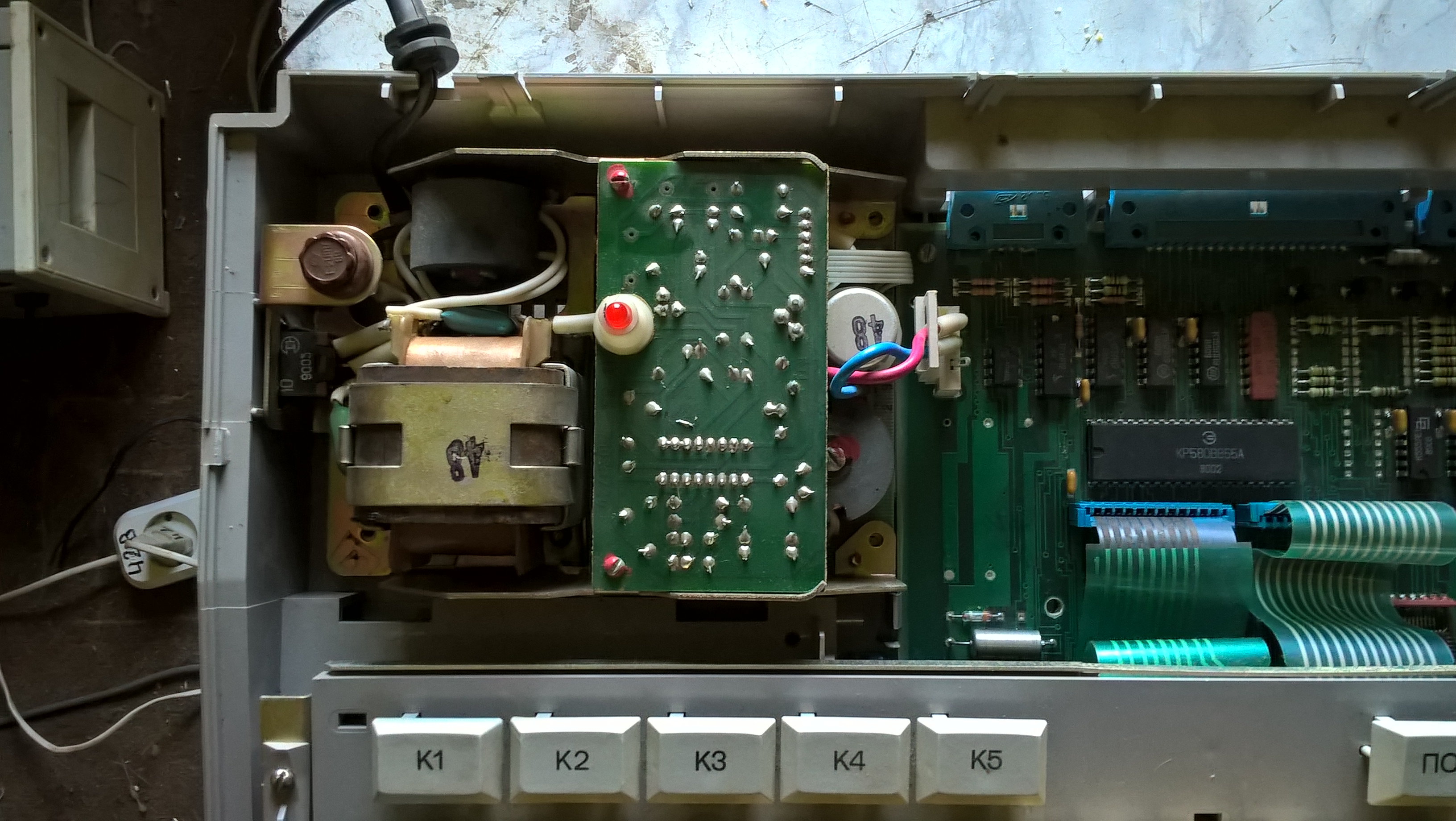
The 42V power supply unit is pulsed, it gives out + 5V 2A and this is enough for powering not only the UKSC itself, but also expansion cartridges that are installed in 2 slots on the right side of the board.
I myself saw a ROM cassette with Vilnius Basic, a disk drive controller, an IDE HDD controller, a 512 Kb RAM disk.
Here is a photo of the board with a power connector close up.
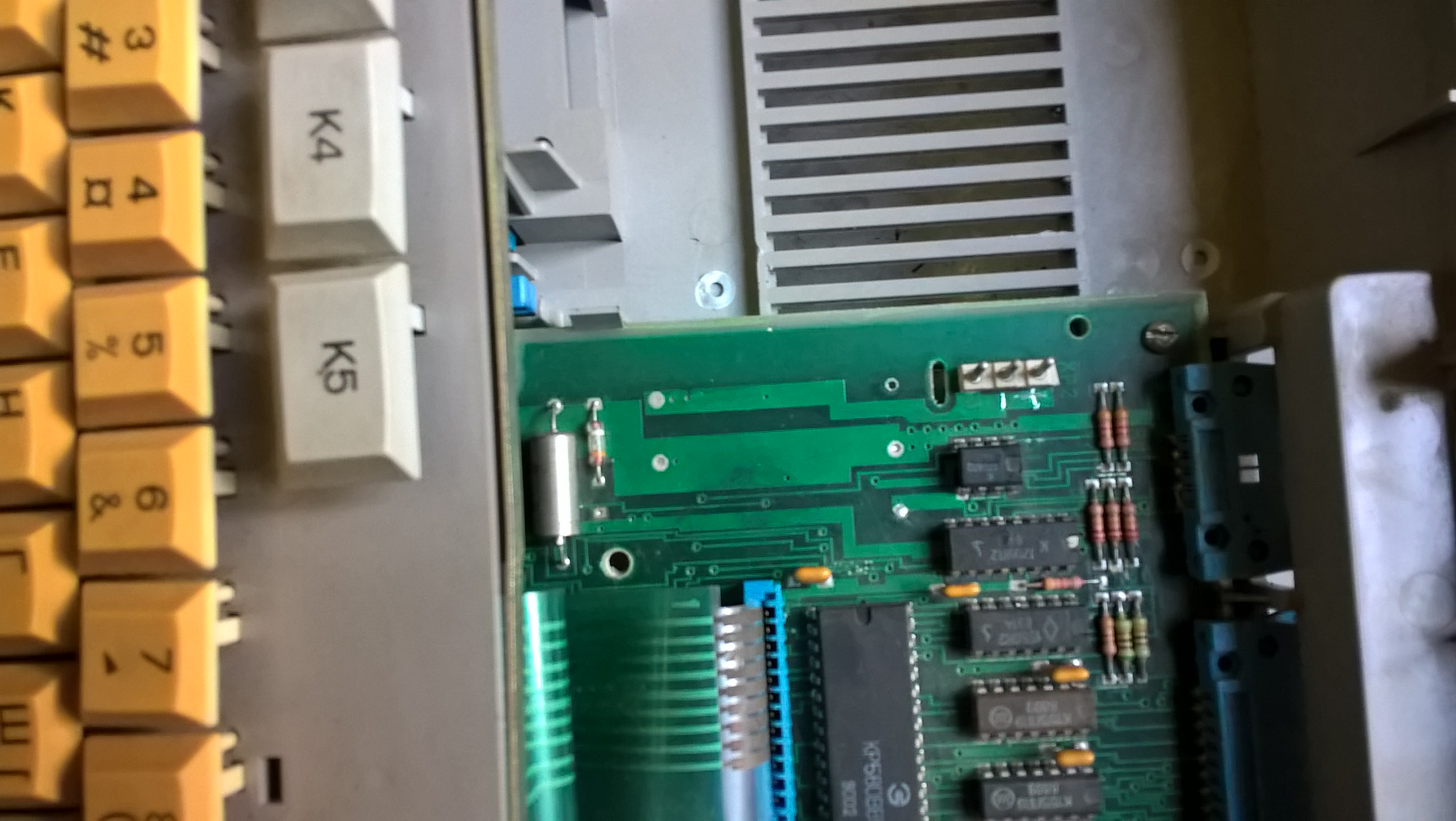
The "+" sign marked + 5V, the "-" sign noted GND.
Nearby on the board-free part of the board there are 5 holes - 2 in one row closer to the keyboard and 3 closer to the power connector. This is the footprint for installing a DC-DC converter for power supply for the Butt C2 interface ICs. As long as no ± 12V power supply is applied to them, nothing can be connected to the COM port.

Some details about the blue connectors facing the rear panel of the case.
The short blue connector is near the power supply unit; the Russian version of the IDC10 with snaps is the C2 joint, the same COM port. Next to it, a wide blue analog IDC40 is a programmable parallel port made on a big black chip KR580BV55A - it can be freely programmed and can work not only as an LPT analog, but even as an external bus for exchanging with equipment, it all depends on the driver. The remaining two IDC10 - connected to the monitor outputs in parallel - the signals RGB + SYNC + composite-video + sound-beeper and of course the "ground". The latest DIN5 is a tape recorder port through which you can play audio tapes of programs with a computer from an MP3 player, or solder cords to a PC audio card and carry out loading and unloading in both ways. And finally, the button - hard reset. If everything is frozen tightly - feel free to wait for her.
And here is a photo of the rest of the board, if you remove the keyboard.

The big blue connector below the power supply is actually an adapter clad on the lamella of the edge connector that implements the bus MPI adopted in Soviet systems as an analogue of Q-BUS DEC. The bus is 16-bit multiplexed, data and addresses are transmitted over one line with time separation. At the second end of the "extension cord" the edge of the "local network" board is visible.
The local network of the UKSC is built according to the architecture of the ring bus on a 1801VP1-065 microcircuit that implements the Ctyk C2 interface operating at a given speed of 57600.
In addition, two 1801VM2 processors are visible on the UKNTs board, the KA1515XM matrix logic chips are analogs of the chipset that are once programmed at the FPGA, standard 1801VP1-xxx for various purposes, ROM and RAM 565RU5, fine logic and sometimes good green KMs. ki causing saliva outflows of stupid and greedy baryg metallers, in them is tantalum!
DSC PDP-11 was created according to the classical mini-computer architecture as a “terminal machine”, a central processor with its memory and a “terminal” connected to it using the standard register 177560. That is why there are two identical 1801BM2 processors on the motherboard. On the actual board, there are 2 computers working independently of each other most of the time. The Main (Central Processor) - on its 1801BM2 processor and with its 56 kb memory “terminal machine” architecturally close LSI-11/03 which through the register in memory can work with any terminal, standardly with a teletype or RS-232C terminal. And the second 1801VM2 (Peripheral Processor) with its 32 kb memory which works as a terminal, leading data exchange with the main “machine” through the “standard register 177560 emulator” implemented by the circuitry chipset of the UKSC.
The second processor serves the keyboard, the monitor video system has 3 memory banks of 32 KB each, I / O ports, loads the system and implements a “console” mode for debugging and controlling the central processor. Yes, you heard right, at any time you can stop the execution of the main processor program and view and edit memory with your hands, and then start the program again. And on the second processor of the “built-in terminal” you can run your own separate program, when the “main processor” is busy with its task, the terminal has 22 kb of free memory.
But back from the wilds of the DEC architecture in the Soviet version to our history - to the replacement of the power supply.
Here is his photo.
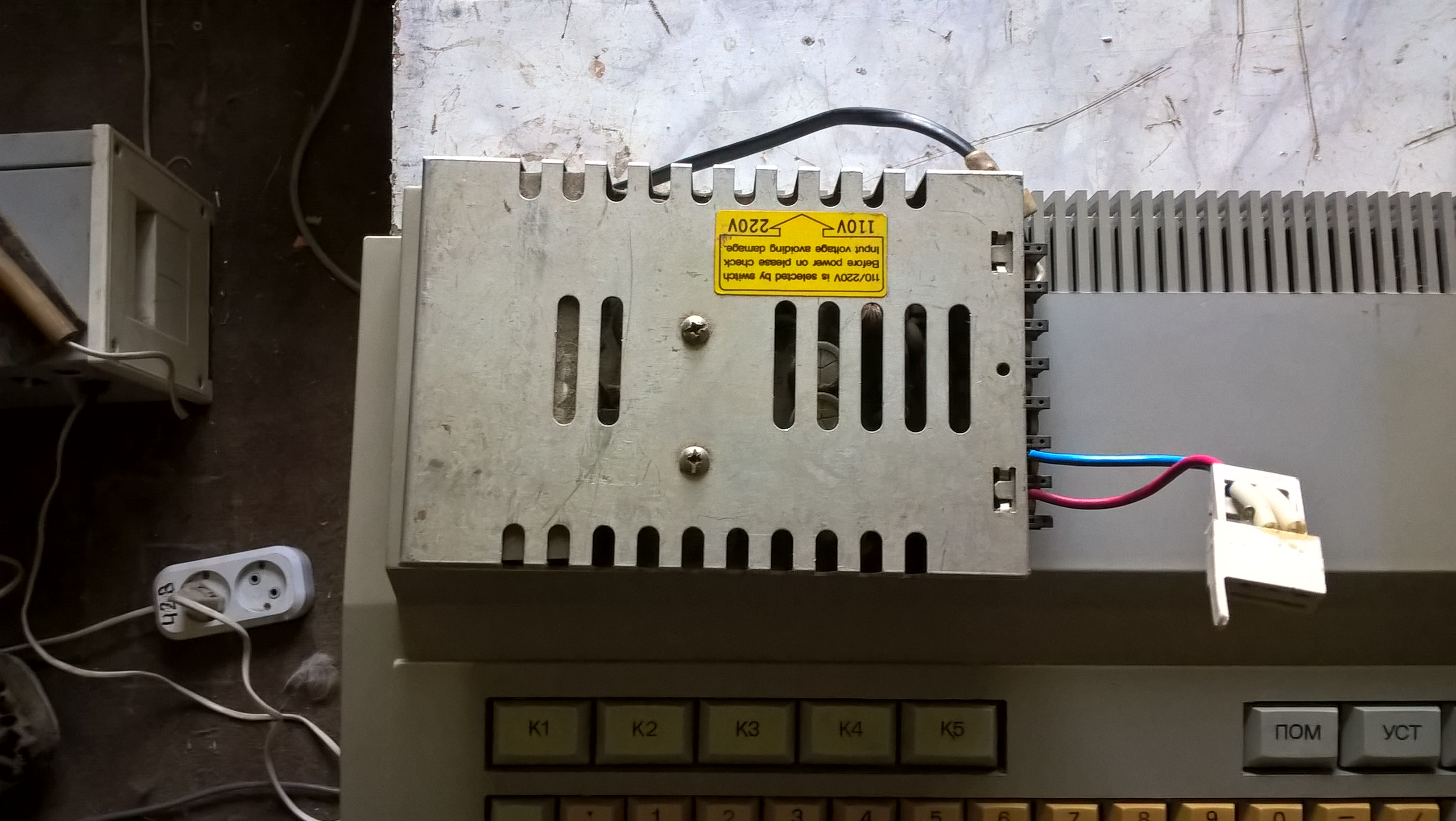
Unplugged the power cord with a connector from the old power supply, the red wire - + 5V, blue - GND.
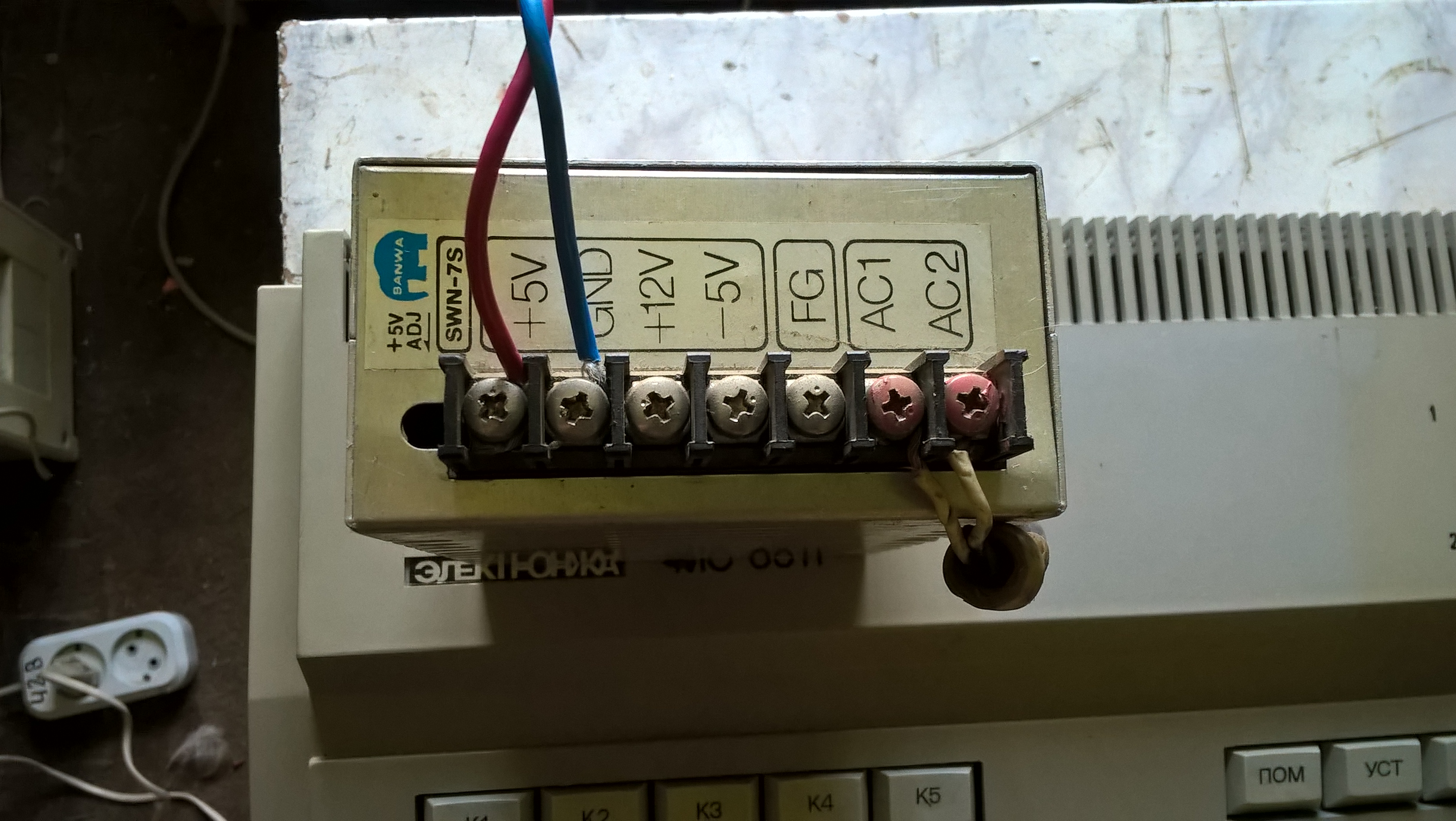
Power terminals for 220 and output ± 5 and + 12V.
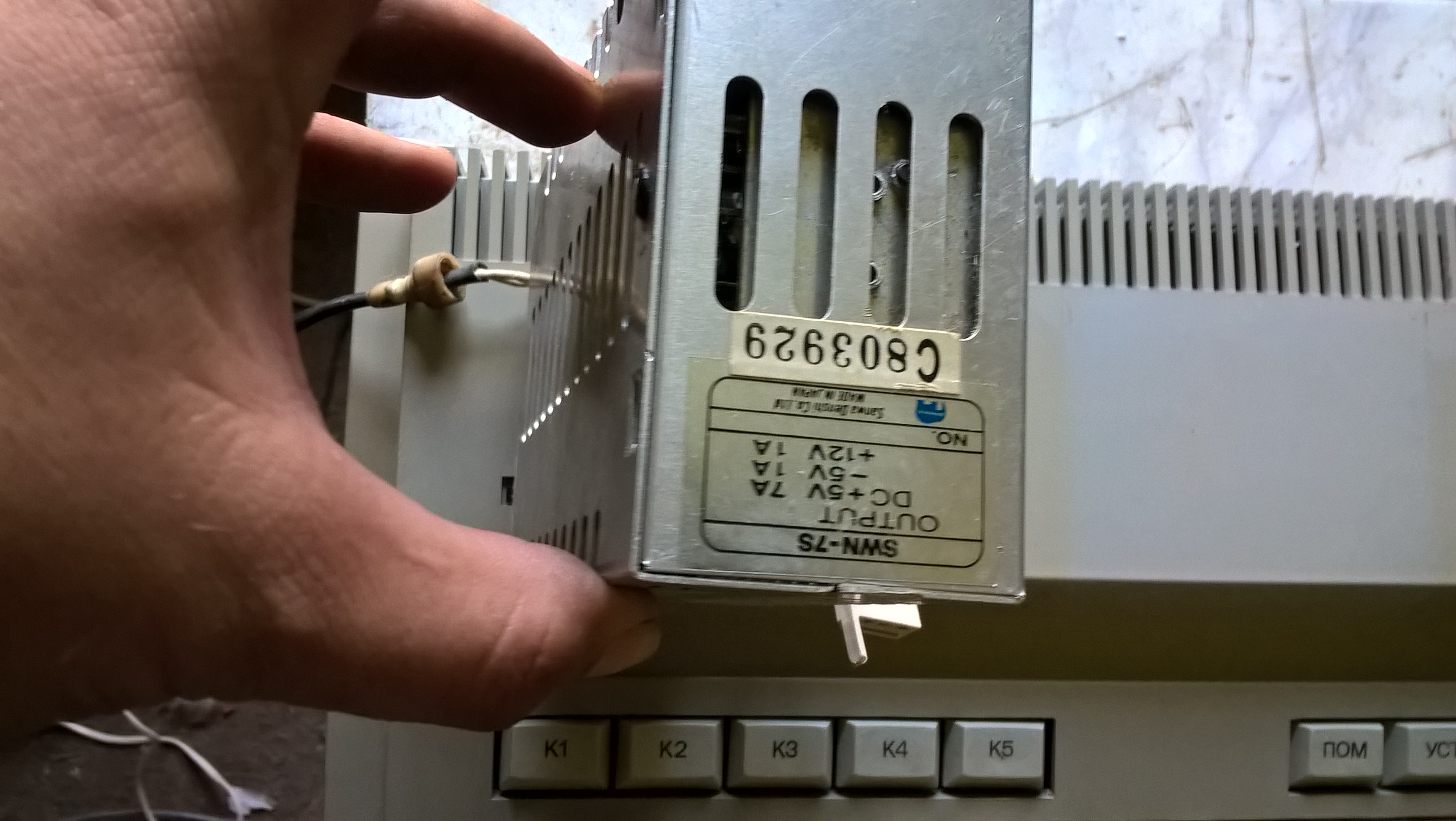
A label with voltages and currents on different channels of the power supply.
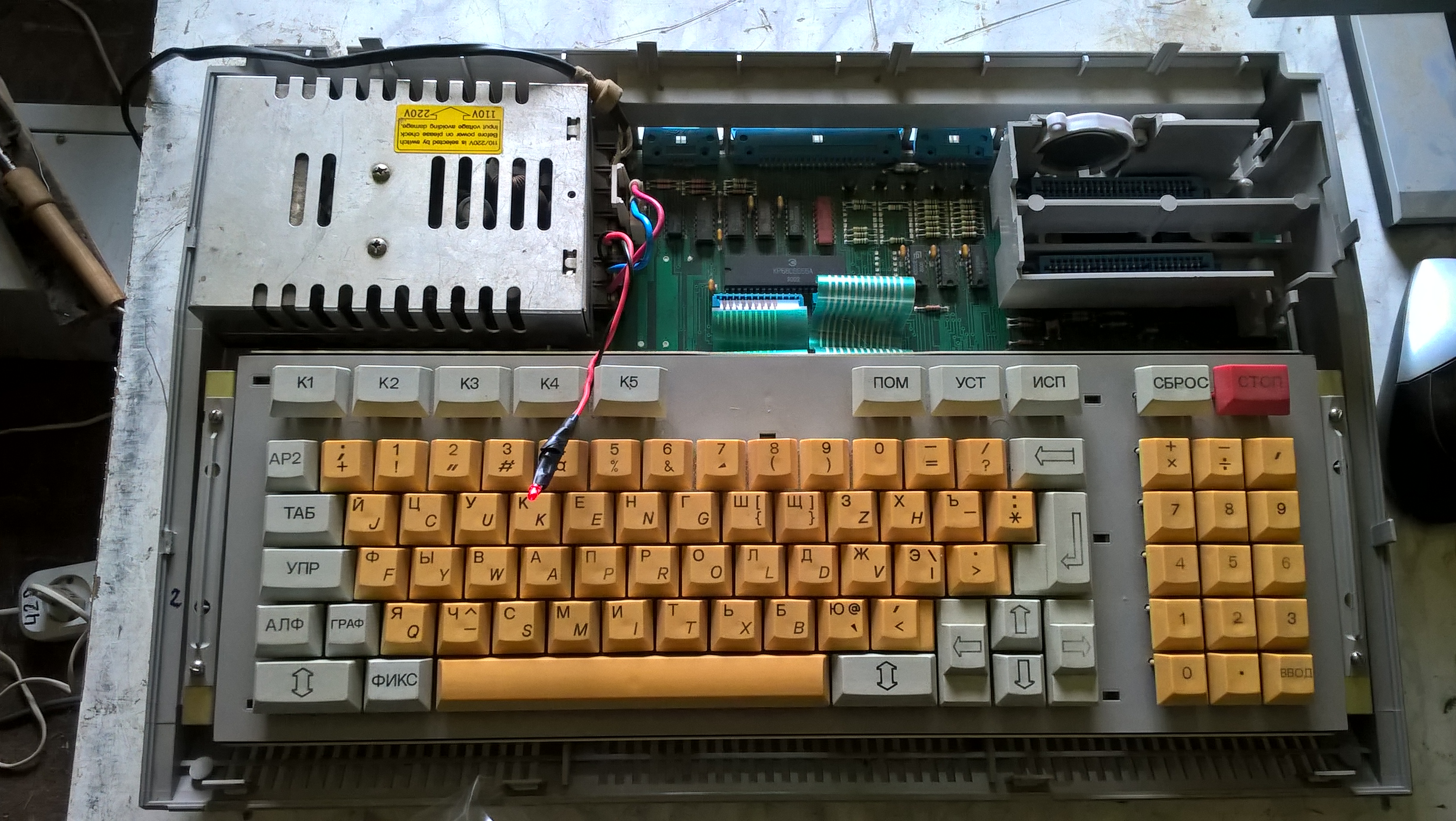
The power supply ideally sat in the place of the old one after it was necessary to break out the fasteners for the screws and bite a couple of small reinforcement ribs. The power supply does not hang, even connected a red LED with a current-limiting resistor of 2.8 kΩ to indicate the operation of the BP on the + 12V channel. But the power supply unit tightly takes place inside the case and does not allow to put the power button in its native place, so for now - turn on and off only with a plug in the socket. This is certainly better than the native power supply and a huge buzzing box of a step-down transformer nearby.
Now I’m waiting for a package with a ± 12V converter imported from Chip & Dip to come in, the Soviet one can’t be found and I don’t know its brand. Also, I am waiting for the EGA-CGA-RGB to VGA GBS-8220 converter to arrive from China to connect my ESC to a modern monitor. My old small monitor MS 6105.02 cannot catch synchronization with the UKSC and the image is floating as it is not adjusted.
We also plan to buy a combined FDD + IDE-CF controller for which the drive emulator has already been purchased, which allows you to connect DSK format floppy disk images with programs for the UKNC from a USB flash drive and run the RT-11 OS. In the future, a CF card with 32 MB sections created by RT-11 disks will be connected, which sections more than 65,535 blocks of 512 bytes each does not understand and the system will be launched “from HDD”.
So far the seller of controllers has some difficulties with the purchase of components for assembly and we have to wait. When the converter arrives on the monitor, there will be a continuation of the article about connecting the UKSC to the VGA monitor. When there will be a disk controller - an article about connecting them and running the OS.
Everyone who worked with UKSC, DVK, Electronics-60, SM-4, SM-1420 with real DEC PDP-11 / LSI-11 / VAX-11 - write, comment, share experiences, remember youth as I am.
Good luck everyone, see you all!
The second part of the story habr.com/ru/post/458402
For me, this old car is interesting not only because it is built on the architecture of the PDP-11 and is not a direct clone of some kind of “western” car, but also nostalgic. It was the first real computer with which I dealt, before that there was only an experience with the programmable calculator Electronics MK-61. Which still works for me and I use it when I need to do the calculations, and sitting and coding in C ++ is too lazy. His reverse Polish notation well “enters into a stupor” of modern people, with their question “How should we count on it? Where is the button equal? ”But the article is not MK-61, although of course it’s also interesting, but about the UKSC.
I will not retell the story of creation and the performance characteristics of the UKSC, those who wish can read the article on the link in Wikipedia .
Other links with descriptions and photos are also easily accessible on Google, as well as the emulator which can be viewed here . In the same place documentation, archive of software and all the rest if who becomes interested.
')
In the meantime, I will briefly talk about UKSC. This is a computer-monoblock where the keyboard is built into the case. In the 80s, when the UKSC was developed as a standard solution for consumer PCs, it’s worth remembering the ZX-Spectrum, Amiga, Commodore, MSX and all the other “fed-up keyboards with a processor inside”.
And now I will not tire the venerable public with the sheets of the text and will start uploading the photo.


My copy of the UKSC, in fairly good condition for its age. This is a student model with a power supply at 42V 50 Hz, released in 1990 at the Kvant factory.
Despite the fact that the computer is almost 30 years old - it works.
A feature of the student model is a 42V power supply according to the rules of electrical safety and not soldered to save DC-DC converter +5 then ± 12V for power supply of interface chips of the Port C2 port which is a direct electrical analog of RS232 but with a Soviet connector and a different pinout.
I have a laboratory transformer 220-36 / 42B and he allowed to check the UKSC, but in modern conditions I consider its use not justified. It takes up a lot of space and buzzes quite loudly. For this reason, I decided to replace the UKNSC's power supply unit with a modern industrial power supply unit of a small size.
With the outer lid open, it is fastened with latches along the perimeter of the housing of the UKSC.


The 42V power supply unit is pulsed, it gives out + 5V 2A and this is enough for powering not only the UKSC itself, but also expansion cartridges that are installed in 2 slots on the right side of the board.
I myself saw a ROM cassette with Vilnius Basic, a disk drive controller, an IDE HDD controller, a 512 Kb RAM disk.
Here is a photo of the board with a power connector close up.

The "+" sign marked + 5V, the "-" sign noted GND.
Nearby on the board-free part of the board there are 5 holes - 2 in one row closer to the keyboard and 3 closer to the power connector. This is the footprint for installing a DC-DC converter for power supply for the Butt C2 interface ICs. As long as no ± 12V power supply is applied to them, nothing can be connected to the COM port.

Some details about the blue connectors facing the rear panel of the case.
The short blue connector is near the power supply unit; the Russian version of the IDC10 with snaps is the C2 joint, the same COM port. Next to it, a wide blue analog IDC40 is a programmable parallel port made on a big black chip KR580BV55A - it can be freely programmed and can work not only as an LPT analog, but even as an external bus for exchanging with equipment, it all depends on the driver. The remaining two IDC10 - connected to the monitor outputs in parallel - the signals RGB + SYNC + composite-video + sound-beeper and of course the "ground". The latest DIN5 is a tape recorder port through which you can play audio tapes of programs with a computer from an MP3 player, or solder cords to a PC audio card and carry out loading and unloading in both ways. And finally, the button - hard reset. If everything is frozen tightly - feel free to wait for her.
And here is a photo of the rest of the board, if you remove the keyboard.

The big blue connector below the power supply is actually an adapter clad on the lamella of the edge connector that implements the bus MPI adopted in Soviet systems as an analogue of Q-BUS DEC. The bus is 16-bit multiplexed, data and addresses are transmitted over one line with time separation. At the second end of the "extension cord" the edge of the "local network" board is visible.
The local network of the UKSC is built according to the architecture of the ring bus on a 1801VP1-065 microcircuit that implements the Ctyk C2 interface operating at a given speed of 57600.
In addition, two 1801VM2 processors are visible on the UKNTs board, the KA1515XM matrix logic chips are analogs of the chipset that are once programmed at the FPGA, standard 1801VP1-xxx for various purposes, ROM and RAM 565RU5, fine logic and sometimes good green KMs. ki causing saliva outflows of stupid and greedy baryg metallers, in them is tantalum!
DSC PDP-11 was created according to the classical mini-computer architecture as a “terminal machine”, a central processor with its memory and a “terminal” connected to it using the standard register 177560. That is why there are two identical 1801BM2 processors on the motherboard. On the actual board, there are 2 computers working independently of each other most of the time. The Main (Central Processor) - on its 1801BM2 processor and with its 56 kb memory “terminal machine” architecturally close LSI-11/03 which through the register in memory can work with any terminal, standardly with a teletype or RS-232C terminal. And the second 1801VM2 (Peripheral Processor) with its 32 kb memory which works as a terminal, leading data exchange with the main “machine” through the “standard register 177560 emulator” implemented by the circuitry chipset of the UKSC.
The second processor serves the keyboard, the monitor video system has 3 memory banks of 32 KB each, I / O ports, loads the system and implements a “console” mode for debugging and controlling the central processor. Yes, you heard right, at any time you can stop the execution of the main processor program and view and edit memory with your hands, and then start the program again. And on the second processor of the “built-in terminal” you can run your own separate program, when the “main processor” is busy with its task, the terminal has 22 kb of free memory.
But back from the wilds of the DEC architecture in the Soviet version to our history - to the replacement of the power supply.
Here is his photo.

Unplugged the power cord with a connector from the old power supply, the red wire - + 5V, blue - GND.

Power terminals for 220 and output ± 5 and + 12V.

A label with voltages and currents on different channels of the power supply.

The power supply ideally sat in the place of the old one after it was necessary to break out the fasteners for the screws and bite a couple of small reinforcement ribs. The power supply does not hang, even connected a red LED with a current-limiting resistor of 2.8 kΩ to indicate the operation of the BP on the + 12V channel. But the power supply unit tightly takes place inside the case and does not allow to put the power button in its native place, so for now - turn on and off only with a plug in the socket. This is certainly better than the native power supply and a huge buzzing box of a step-down transformer nearby.
Now I’m waiting for a package with a ± 12V converter imported from Chip & Dip to come in, the Soviet one can’t be found and I don’t know its brand. Also, I am waiting for the EGA-CGA-RGB to VGA GBS-8220 converter to arrive from China to connect my ESC to a modern monitor. My old small monitor MS 6105.02 cannot catch synchronization with the UKSC and the image is floating as it is not adjusted.
We also plan to buy a combined FDD + IDE-CF controller for which the drive emulator has already been purchased, which allows you to connect DSK format floppy disk images with programs for the UKNC from a USB flash drive and run the RT-11 OS. In the future, a CF card with 32 MB sections created by RT-11 disks will be connected, which sections more than 65,535 blocks of 512 bytes each does not understand and the system will be launched “from HDD”.
So far the seller of controllers has some difficulties with the purchase of components for assembly and we have to wait. When the converter arrives on the monitor, there will be a continuation of the article about connecting the UKSC to the VGA monitor. When there will be a disk controller - an article about connecting them and running the OS.
Everyone who worked with UKSC, DVK, Electronics-60, SM-4, SM-1420 with real DEC PDP-11 / LSI-11 / VAX-11 - write, comment, share experiences, remember youth as I am.
Good luck everyone, see you all!
The second part of the story habr.com/ru/post/458402
Source: https://habr.com/ru/post/458166/
All Articles